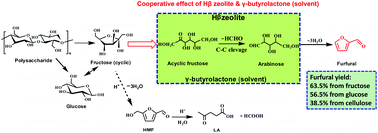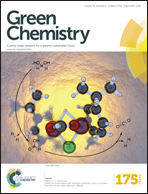Conversion of carbohydrates to furfural via selective cleavage of the carbon–carbon bond: the cooperative effects of zeolite and solvent†
Abstract
Furfural is one of the most valuable biomass-derived platform molecules which is primarily produced from hemicellulose. It is of significant importance but still highly challenging to produce furfural from hexoses, which are extensively distributed in nature. In this paper, carbohydrates (cellulose, starch, inulin, maltose, sucrose, glucose and fructose) were transformed into furfural efficiently over Hβ zeolite in a γ-butyrolactone–water solvent. The key process for converting hexoses into furfural is the selective cleavage of the C–C bond in hexoses to pentoses. The Hβ zeolite was discovered to induce the formation of acyclic hexoses, and the synergy between Hβ and solvent enables the selective C–C bond cleavage of acyclic hexoses into pentoses and promotes the subsequent dehydration of pentoses into furfural. Furfural yields for converting fructose and glucose reached 63.5% and 56.5% under milder conditions (150 °C), respectively. Moreover, a favorable yield of 38.5% for furfural can be achieved by direct conversion of cellulose.


 Please wait while we load your content...
Please wait while we load your content...